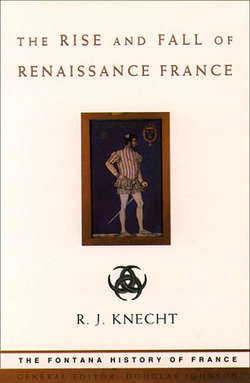Читать книгу The Rise and Fall of Renaissance France - R. Knecht J. - Страница 34
The Concordat of Bologna (1516)
ОглавлениеThe Concordat of Bologna was approved by the pope on 18 August 1516, but before it could become law in France it had to be registered by the Parlement of Paris, and Francis I was allowed six months in which to get this done. The parlement, however, was deeply suspicious of a settlement which threatened to undermine, if not to destroy, the liberties of the Gallican church, as enshrined in the Pragmatic Sanction. Although it was asked on 5 February 1517 to register the Concordat, it took more than two years to comply and Francis had to obtain an extension of the deadline he had been given. The parlement’s delaying tactics angered him so much that in June 1517 he ordered his uncle, René of Savoy, to attend the court’s debates. The parlement protested at this infringement of its liberties, but had to submit when Francis threatened to replace its members by ‘gens de bien’ (worthy men). Despite René’s presence, the parlement still would not register the Concordat. Its refusal was conveyed to the king at Amboise by two parlementaires, who had to face his wrath. There would be only one king in France, he declared, and no Senate as in Venice. He threatened to make the parlement ‘trot after him like the Grand conseil’ and accused it of neglecting its judicial duties. When the envoys asked for permission to delay their departure until local floods had subsided, they were told that if they had not left by morning they would be thrown into a deep pit and left there for six months. On 6 March 1518 the king again demanded registration of the Concordat. He was said to be planning to set up a rival parlement at Orléans. The threat achieved its purpose and on 22 March the parlement finally gave way: the Concordat was registered, albeit with the addition of a phrase indicating duress. At the same time, the parlement secretly declared that it would continue to apply the Pragmatic Sanction in ecclesiastical disputes.
No sooner had the parlement capitulated than the University of Paris began to agitate, fearing that its graduates would lose the privileged position given to them by the Pragmatic Sanction in respect of collation to ecclesiastical benefices. The university suspended its lectures, forbade anyone to print the Concordat, and appealed to a future General Council. A memorandum denouncing the Concordat was circulated to preachers for use in their Lenten sermons. Placards to the same effect were put up in colleges and public places. Francis ordered the parlement to intervene; otherwise, he threatened to apply the severest measures. A few days later he appointed a special commission to enquire into the disorders. College principals were ordered to restrain their students. On 25 April the university was forbidden to meddle in state affairs under pain of loss of its privileges and banishment from the kingdom.
It is commonly assumed that the main purpose of the Concordat was to increase the king’s control of the Gallican church and that, having won the battle of Marignano, he had imposed his terms on Leo X. Both assumptions, however, are questionable. The crown, as we have seen, already had extensive control of the church before 1516. After 1438 the church was governed in theory by the Pragmatic Sanction, which allowed chapters the right to elect bishops and abbots; but the monarchy often determined the outcome of elections. By 1515 royal control of the ecclesiastical hierarchy was an accepted fact. This was acknowledged by the president of the parlement in March 1515, when he begged Francis to appoint worthy men of sufficient years to administer sees and religious houses.
Marignano did not give Francis mastery of Italy. He remained vulnerable in the north, nor could he impose terms on the pope. The king needed Leo not merely to safeguard his own gains in north Italy but also to acquire territory farther south. In February 1516, on learning of the death of Ferdinand of Aragon, Francis ‘decided to try to recover the kingdom of Naples’. To achieve this, however, he needed the pope’s help. As temporal ruler of the States of the Church, Leo controlled the overland route south; as suzerain of Naples, he alone could grant its investiture. So Francis decided to satisfy the long-standing papal demand for the annulment of the Pragmatic Sanction, even though this meant offending his subjects. It was primarily to win papal support for his Italian policy that he signed the Concordat.
As a political move, the Concordat was a failure. After supporting the king of France, Leo X ditched him in 1521. Yet Francis was never tempted to revoke the Concordat. As long as he hoped to re-establish his rule in Italy he tried to remain on good terms with the Holy See. As an ecclesiastical settlement, the Concordat was a bargain struck by the king and the papacy at the expense of the Gallican liberties. It restored papal authority in France while legalizing and enlarging royal control of church appointments. Yet the king was not given unlimited control: the pope retained the right of instituting royal nominees and of setting aside any whose qualifications fell short of the canonical requirements. Some churches were also allowed to continue electing their superiors. In practice, however, the Concordat was not strictly applied: the king imposed his candidates on churches claiming the privilege of election, and in June 1531 he obtained from the pope the annulment of this privilege, except in respect of religious houses. Francis also sometimes ignored canonical requirements. Very occasionally the pope refused to institute a royal nominee, but this was exceptional. In general the Concordat strengthened royal control of the Gallican church.
